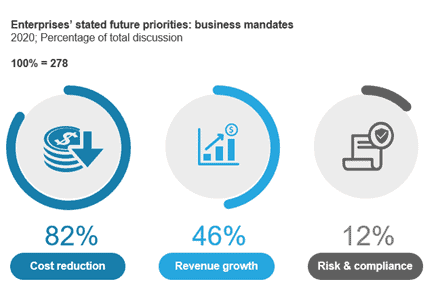Blog
Productization Emerges in Media Services – A Shift Driven by Technology

Leveraging the power of Artificial Intelligence (AI) and data and analytics tools, media and communications companies are redefining themselves from being service providers to product creators. Read on to learn how emerging technology is changing the game in media services.
While technology has played a pivotal role in media services for some time, use cases have increased and grown in complexity in recent years. AI and data and analytics are now widely used across the media planning and buying value chain. Moreover, media agencies are emphasizing developing in-house tools, solutions, and products based on data and analytics, AI, and the Internet of Things (IoT) to gain a competitive edge and propose a distinguished value proposition to their clients. Let’s explore this shift further.
Rising momentum in adopting emerging technology in the media services value chain
Essentially, the media services value chain consists of four broad components – media strategy and planning, creative development, buying and execution, and analytics and measurement as depicted below:
Exhibit 1: Media planning and buying value chain

In the early days, technology was mainly used for basic tasks such as segmenting audiences, measuring media campaign analytics, and automating simple processes that were focused on a single segment.
Next, the focus shifted to programmatic advertising, automating the media buying process. Further advancements in AI-enabled programmatic media buying have spurred media agencies to invest in media marketplaces.
For example, GroupM launched Premium Marketplace, a unified programmatic marketplace with increased media buying transparency and efficiency. Omnicom Media Group introduced a programmatic marketplace for point-of-purchase screens in the US. Moreover, Publicis Media launched a programmatic marketplace that allows brands to reach underrepresented communities.
The advancements in the ease of use of AI and IoT combined with the growing prowess of data and analytics has unleashed intricate new use cases across the entire media services value chain, opening new avenues for media agencies.
As the number of channels and consumer touchpoints continue to proliferate, the emphasis has shifted to analyzing complex audience segments; automating complex processes; developing accelerated, customized, and optimized media plans across channels; and analyzing and maintaining elaborate data sets of user journeys.
AI and a data-driven approach enables audience building at a granular level, creating a single customer view and delivering highly personalized customer experiences.
Exhibit 2: Use cases of technology in the media services domain

Rise of productization in media services
Increasingly, media companies are investing in platforms, in-house solutions, and tools to expand their offerings and reposition themselves from being pure play professional service providers. Agencies under the parent brand also are leveraging these investments to drive greater synergies by maintaining large in-house data sets and collecting user journey data.
As margins become thinner in the core media services, the momentum toward productization has opened a new revenue stream for media agencies. Some notable examples of these investments include:
- Wavemaker’s media planning tool Maximize, an AI-powered media planning platform, creates media plans to reach multiple audiences and optimize media investments
- Omnicom Group’s Omni, a precision marketing and insights platform, is designed to identify and define personalized consumer experiences at scale
- Performics’ suite includes tools for search optimization, customized user journeys, brand discovery, and Amazon advertising bid strategy
- Tinuite’s Mobius suite includes proprietary apps consisting of MobiusOS, Mobius Apps, and MobiusX
- Havas Media’s Converged, an identity-based planning and buying platform, aims to deliver stronger insights, tighter targeting, and a more consistent customer journey
Other investments and partnerships to elevate the power of these platforms by integrating additional data sources include Omnicom’s Omni partnerships with Walmart Connect and NBCU Audience Insights Hub; and Wavemaker working with Amazon Advertising’s Overlapping Audiences API to access Amazon’s audience insights into media plans and campaigns.
The launch of channel-specific solutions is another example of the growth in productization. This can be seen in GroupM Australia’s launch of a custom-built, data-driven Digital Out of Home (DOOH) planning and activation platform that enables advertisers to deliver audience-based DOOH campaigns across premium sites. Further, GroupM developed Sightline, a dedicated digital out-of-home solution, which combines programmatic technology and AI with GroupM’s buying scale.
In addition to media agencies, neutral ad-tech platforms such as The Trade Desk and Xandr have invested in developing in-house platforms. Solimar by The Trade Desk has cross-channel precision and measurement capabilities and unleashes the power of first-party data. LiveRamp’s Safe Haven enterprise platform enables data gathering from multiple sources, transforms it into a connected customer view, and then activates at scale.
Is metaverse the next big thing for media services?
Interestingly, as the industry still explores the potential of the metaverse, media agencies have started executing pilot projects in this area. Publicis Groupe now has over 1000 employees dedicated to metaverse projects. WPP has incubated a metaverse foundry, while Wavemaker recently executed a wedding in the metaverse.
The outlook
Driven by in-house data sets and aggregating data through APIs, technology has changed the focus of media agencies toward offering products. This has given them new opportunities to unlock additional revenue streams and deliver distinguished value propositions.
Looking ahead, AI, data and analytics, and enablers such as the metaverse will continue to impact the dynamics of the media services value chain, and we can expect to see more investments in the near term.
To discuss technology in media services, please reach out to Nisha Krishan or Aakash Verma.
Explore more about evolving technologies what we could expect from the metaverse, watch our webinar, What to Expect from the Metaverse in 2023: Moving Beyond Hype.